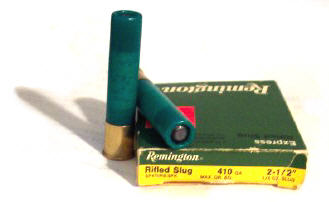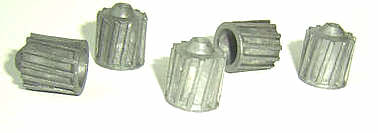
 |
 |
A
Serious Look at the .410 Slug
By Marshall Williams. |
 |
|
Several years ago, a Shotgun Sports Magazine reader inquired whether the .410 bore slug loads were suitable for deer hunting. The late and highly knowledgeable Stan Baker responded by comparing the .410 bore slug's 640 foot pounds of muzzle energy with the 12 slug load's 2400 foot pounds of muzzle energy, and the .30-30 rifle's 1800 foot pounds of muzzle energy. Since both of the latter were excellent and well proven deer cartridges, and since the little .410 slug had less than one-third of the energy of the .30-30 and less than one-fourth of the energy of the 12 gauge slug, Stan concluded that the little .410 slugs were not suitable for deer hunting. Stan was in good company. Every comment that I have ever seen regarding the little slugs reached the same conclusion, it is inadequate for deer. In fact, I have never heard of anyone endorsing the .410 slug as adequate for anything but small animals. One commentator had gone so far as to say they might be capable of killing coyotes, but regarded their accuracy as inadequate for coyote hunting. Indeed, few commentators will acknowledge that the .410 is useful for chasing rats around a corn crib. I also note that no commentator within my knowledge ever said that he had shot any flesh and blood thing with a .410 slug. I hasten to add that I have not either, but when I was a teenager and hunted small game with the .410, the small game season in Virginia overlapped the deer season, and I always carried a couple of the slugs with me. If I had seen a deer at close enough range to surely place the little slug in his heart-lung area, I would not have hesitated to try it. I had been confident about it then, and remained confident about the little slug's adequacy, I decided I should critically assess the matter. In the first place, proof that one thing works is never proof that something else does not work. As I thought about this, it dawned on me that comparing the .410 slug's suitability for deer by comparing it with a 12 gauge slug or a .30-30 rifle was an "apples and oranges" comparison. That led me to think about performance. The traditional 1/5 oz. .410 slug weighs about 87.5 grains, starts with a muzzle velocity of 1815 fps, and generates 640 ft. lbs. of muzzle energy. Compared with the .30-30's 1800 or so ft. lbs or energy or the one ounce 12 gauges slugs with over 2400 ft. lbs of muzzle energy, the little .410 slug looks puny indeed. But 640 ft. lbs. of energy is certainly something. What? Well, for starters, it virtually duplicates the ballistics of a .40 caliber muzzle-loading rifle both at the muzzle and down range. A .39" ball weighs 89 grains and will slow down about as fast as the .410 slug. In fact, this seemed to answer a question that had bothered me for many years. Why does the .410 bore slug weigh 1/5 ounce? Or 87.5 grains? In all the other gauges, slug weights are much nearer shot charge weights while the lightest shot charge offered in a modern .410 is noticeably heavier than 1/5 oz. My wild-eyed-guess (Technically this is a WEG.) is that the weight was chosen to approximate the weight of the round ball used in .410s before the Foster slug became standard. I soon realized that a number of other cartridges had characteristics similar to the .410 slug's muzzle energy, 640 ft. lbs. And its diameter. For example, top loads from a 10mm auto pistol, a .357 magnum revolver, and the standard velocity ballistics of the .44-40 and .38-40 rifles all are in the same class. All of these other guns, the .40 muzzle-loader, the 10mm auto, the .357 magnum revolver, the .44-40 rifle, and the .38-40 rifle, are considered suitable for deer, at least under some circumstances. Within ranges assuring adequate bullet placement, I could think of no reason why the .410 slug should be less effective. Better comparisons notwithstanding, I still had never shot any flesh-and-blood thing with a .410 slug, nor did I know anyone who had. Standing alone, my "better" favorable comparisons were no better than anyone else's unfavorable comparison's. Then, by happy coincidence, an article appeared in a national magazine recounting a beginner's deer hunt which had just taken place. And the best deer, which field dressed at over 250 pounds and was thought to be the biggest white tail deer taken in the US during that year, had been a one-shot kill with a .410 slug. Shot in the heart, the deer had run fifty yards and collapsed. Perfect story, perfect timing. But one shower does not an April make, and maybe it was just beginner's luck. Then, I met a real deer hunter who uses a .410 and slugs. Ed Hines, now
in his early 70s, is a West Virginian who has hunted deer all his life
and is an experienced deer hunter by anybody's standards. Throughout most
of his life, Ed used high powered rifles including a .243 and a .30-06.
Ed had always been a vigorous man who made his living doing concrete and
cinder block contracting. However, in 1993, a stroke affected Ed's right
side and left him unable to drive a car or handle the weight and recoil
of his rifle. But rather than give up deer hunting, Ed got a special hunting
license that allows disabled hunters to shoot from a vehicle, and then
he looked for a gun he could handle, one with minimal recoil and light
enough to be used with just one arm. While other folks might make other
choices, Ed obtained a little single barrel .410, one imported from Korea
by Kassnar, sighted it in for his usual deer shooting distances, and continued
hunting deer.
Ed's hunting technique changed slightly as well. He uses a walker to get
around, and, although no longer able to drive a car on the highways, he
has a riding lawn mower which he operates very well with one hand. A neighbor
takes him to familiar hunting grounds near an apple orchard and Ed often
uses a lawn mower to position himself.
When I asked Ed how many deer he had taken with the little .410, his eyes
twinkled and he replied, "Legally?" I am sure that all of Ed's deer have
been legal, but, in fact, Ed has kept no count of the number of deer he
has taken with his little .410. The West Virginia limits on deer are liberal,
and Ed estimates that he has taken more than twenty with the little .410.
When I asked how many shots it takes to kill a deer, he gave me a look
that reminded me of those my father used to give me when I had said something
particularly stupid, and observed that one has always been enough. However,
as an experienced hunter, Ed is careful about his shots. He only shoots
standing deer and makes sure that they are within appropriate range for
his gun. Ed considers that 30 yards is ideal. Gee, that sounds familiar.
"If I had seen a deer at close enough range to surely place the little
slug in his heart-lung area, I would not have hesitated to try it." Call
me intuitive.
A few additional notes on .410 slugs are in order. While Remington and
Winchester still offer the traditional one-fifth ounce slug, other manufacturers
are starting to offer improvements. Federal now offers a new slug load
containing a quarter ounce slug at 1775 feet per second resulting in a
muzzle energy of 762 foot pounds. Dynamit-Nobel's .410 bore Brenneke slug
weighs 114 grains, or .26 ounce. With a muzzle velocity of 1755 feet per
second, it develops 797 foot pounds of muzzle energy. These energy levels
are entirely comparable to the current .41 magnum revolver. I hope that
I can clear up one final matter relating to oft-quoted data for a .410
slug made from a long obsolete Lyman. Slug mold. I first saw the information
about this slug in my old Lyman Reloading Manual #44, copyright 1967.
The data shows a .410 slug cast of Lyman number 2 alloy and weighing 238
grains, or slightly over half an ounce. This information has been republished
many times and appears in many sources (including some of my own) but
the weight is incorrect. I believe it was a typo and should have read
138 grains. Thus, the top load shown in Lyman's data, 1565 fps, would
have developed 750 ft. lbs of energy.
The .410 slug mold was not popular and was discontinued before 1970. However,
pure lead slugs cast from an original Lyman mold are available from a
commercial bullet caster, Liberty Reloading Supplies (see below). Their
pure lead slug weighs 140 grains and is .372 inches in diameter.
I also note that unlike all of Lyman's other slug data, the .410 data
called for casting the .410 slug from Lyman Number 2 alloy. This alloy
is much harder than the pure lead recommended for all other slugs. In
fact, it is nearly as hard as Linotype. Why it was used for the .410 slug,
but no others, is not explained. Ed Hines, now
in his early 70s, is a West Virginian who has hunted deer all his life
and is an experienced deer hunter by anybody's standards. Throughout most
of his life, Ed used high powered rifles including a .243 and a .30-06.
Ed had always been a vigorous man who made his living doing concrete and
cinder block contracting. However, in 1993, a stroke affected Ed's right
side and left him unable to drive a car or handle the weight and recoil
of his rifle. But rather than give up deer hunting, Ed got a special hunting
license that allows disabled hunters to shoot from a vehicle, and then
he looked for a gun he could handle, one with minimal recoil and light
enough to be used with just one arm. While other folks might make other
choices, Ed obtained a little single barrel .410, one imported from Korea
by Kassnar, sighted it in for his usual deer shooting distances, and continued
hunting deer.
Ed's hunting technique changed slightly as well. He uses a walker to get
around, and, although no longer able to drive a car on the highways, he
has a riding lawn mower which he operates very well with one hand. A neighbor
takes him to familiar hunting grounds near an apple orchard and Ed often
uses a lawn mower to position himself.
When I asked Ed how many deer he had taken with the little .410, his eyes
twinkled and he replied, "Legally?" I am sure that all of Ed's deer have
been legal, but, in fact, Ed has kept no count of the number of deer he
has taken with his little .410. The West Virginia limits on deer are liberal,
and Ed estimates that he has taken more than twenty with the little .410.
When I asked how many shots it takes to kill a deer, he gave me a look
that reminded me of those my father used to give me when I had said something
particularly stupid, and observed that one has always been enough. However,
as an experienced hunter, Ed is careful about his shots. He only shoots
standing deer and makes sure that they are within appropriate range for
his gun. Ed considers that 30 yards is ideal. Gee, that sounds familiar.
"If I had seen a deer at close enough range to surely place the little
slug in his heart-lung area, I would not have hesitated to try it." Call
me intuitive.
A few additional notes on .410 slugs are in order. While Remington and
Winchester still offer the traditional one-fifth ounce slug, other manufacturers
are starting to offer improvements. Federal now offers a new slug load
containing a quarter ounce slug at 1775 feet per second resulting in a
muzzle energy of 762 foot pounds. Dynamit-Nobel's .410 bore Brenneke slug
weighs 114 grains, or .26 ounce. With a muzzle velocity of 1755 feet per
second, it develops 797 foot pounds of muzzle energy. These energy levels
are entirely comparable to the current .41 magnum revolver. I hope that
I can clear up one final matter relating to oft-quoted data for a .410
slug made from a long obsolete Lyman. Slug mold. I first saw the information
about this slug in my old Lyman Reloading Manual #44, copyright 1967.
The data shows a .410 slug cast of Lyman number 2 alloy and weighing 238
grains, or slightly over half an ounce. This information has been republished
many times and appears in many sources (including some of my own) but
the weight is incorrect. I believe it was a typo and should have read
138 grains. Thus, the top load shown in Lyman's data, 1565 fps, would
have developed 750 ft. lbs of energy.
The .410 slug mold was not popular and was discontinued before 1970. However,
pure lead slugs cast from an original Lyman mold are available from a
commercial bullet caster, Liberty Reloading Supplies (see below). Their
pure lead slug weighs 140 grains and is .372 inches in diameter.
I also note that unlike all of Lyman's other slug data, the .410 data
called for casting the .410 slug from Lyman Number 2 alloy. This alloy
is much harder than the pure lead recommended for all other slugs. In
fact, it is nearly as hard as Linotype. Why it was used for the .410 slug,
but no others, is not explained.
With all of this said, I should point out that I would not choose a .410 specifically for deer hunting. However, when I carry one of my favorite .410s to hunt small game, quail, doves, rabbits, woodcock, and squirrels, I will continue to carry a couple of the tiny slug loads in my pocket. I remain confident that if I happen on deer within a range which assures me of placing a slug in its vitals, I will make meat. Liberty Shooting SuppliesPatrick & Victoria GilbertPO Box 357Hillsboro, OR 97123-0357 www.libertyshootingsupplies.com The .410 gauge slugs are listed under muzzle loading bullets. The .372" diameter pure lead 140 grain slugs cost $15 for 50, plus shipping. (Aug.2003)
Reprinted curtesy of
Shotgun Sports Magazine, P.O. Box 6810, Auburn, CA 95604. www.shotgunsportsmagazine.com
|